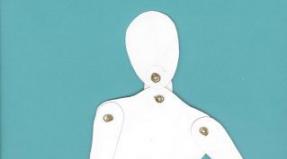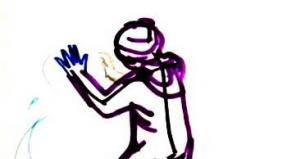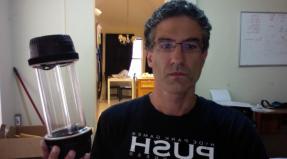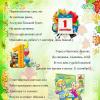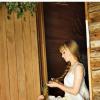Clock (history of invention). The history of the invention and development of watches The history of the transformation of watches
The history of watches goes back thousands of years.
The very first clock on earth was solar. They were ingeniously simple: a pole stuck into the ground. A time scale is drawn around it. The shadow of the pole, moving along it, showed what time it was. Later, such clocks were made of wood or stone and installed on the walls of public buildings. Then came the portable sundial, which was made of precious wood, ivory or bronze. There were even watches that can be conditionally called pocket watches; they were found during excavations of an ancient Roman city. This sundial, made of silver-plated copper, was shaped like a ham with lines drawn on it. The spire - the clock hand - served as a pig's tail. The hours were small. They could easily fit in a pocket. But the inhabitants of the ancient city have not yet invented pockets. So they wore such watches on a cord, chain or attached to canes made of expensive wood.
The sundial had one significant drawback: it could only "walk" on the street, and even then on the sunlit side. This, of course, was extremely inconvenient. That's probably why the water clock was invented. Drop by drop, water flowed from one vessel to another, and by how much water flowed out, it was determined how much time had passed. For many hundreds of years, such watches - they were called clepsydras - served people. In China, for example, they were used 4.5 thousand years ago. By the way, the first alarm clock on earth was also a water one - both an alarm clock and a school bell at the same time. Its inventor is considered the ancient Greek philosopher Plato, who lived 400 years before our era. This device, invented by Plato to call his students to classes, consisted of two vessels. Water was poured into the upper one, from where it gradually flowed into the lower one, displacing air from there. Air through the tube rushed to the flute, and it began to sound. Moreover, the alarm clock was regulated depending on the time of year. Clepsydras were very common in the ancient world.
Sundial. Hourglass.
A thousand years ago, Caliph Harun al-Rashid ruled in Baghdad, the hero of many tales of the Thousand and One Nights. True, in fairy tales he is depicted as a kind and fair sovereign, but in fact he was treacherous, cruel and vindictive. The caliph maintained trade and diplomatic relations with the rulers of many countries, including the Frankish king Charlemagne. In 807, Harun al-Rashid gave him a gift worthy of a caliph - a water clock made of gilded bronze. The hand could show time from 1 hour to 12. When it approached the figure, a ringing sound was heard, which was produced by balls falling on a bronze sheet.
At the same time, figurines of knights appeared, passed in front of the audience and retired.
In addition to water clocks, sand and fire clocks (most often alarm clocks) were also known. In the East, the latter were sticks or cords made from a slowly burning compound.
They were placed on special stands and over the segment of the stick where the fire was supposed to come at a certain time, metal balls were hung low on a thread. The flame approached the thread, it burned out, and the balls fell with a clang into the copper cup. In Europe, for these purposes, they used a candle with divisions printed on it. A pin with a weight attached to it was stuck into the required division. When the candle burned down to this division, the weight fell on a metal tray or simply on the floor.

It is unlikely that there will be a person who will name the first inventor of mechanical watches. Such clocks are first mentioned in ancient Byzantine books (late 6th century). Some historians attribute the invention of purely mechanical clocks to Pacificus of Verona (early 9th century), others to the monk Herbert, who later became pope. He made a tower clock for the city of Magdeburg in 996. In Russia, the first tower clock was installed in 1404 in the Moscow Kremlin by monk Lazar Serbin. They were an intricacies of gears, ropes, shafts and levers, and a heavy weight chained the watch to its place. Such structures have been built over the years. Not only the masters, but also the watch owners tried to keep secret the secrets of the mechanism design.

The first personal mechanical watch was driven by a horse, and a groom monitored their serviceability. Only with the invention of the elastic spring did watches become comfortable and trouble-free. The first pocket watch spring was a pig's bristle. It was used by the Nuremberg watchmaker and inventor Peter Henlein at the beginning of the 15th century.
And at the end of the 16th century, a new discovery was made. The young scientist Galileo Galilei, observing the movement of various lamps in the Pisa Cathedral during the service, found that neither the weight nor the shape of the lamps, but only the length of the chains on which they are suspended, determines the periods of their oscillations from the wind breaking through the windows. He owns the idea of creating clocks with a pendulum.

The Dutchman Christian Huygens knew nothing about Galileo's discovery and repeated it 20 years later. But he also invented a new rate uniformity regulator, which significantly increased the accuracy of the watch.
Many inventors tried to improve watches, and at the end of the 19th century they became an ordinary and necessary thing.
In the 30s of the XX century, quartz watches were created, which had deviations of the daily rate of about 0.0001 seconds. In the 70s, atomic clocks appeared with an error of 10" 13 seconds.
Nowadays, many different watches have been created. The most common are wrist.

Modern clock.
Their dial is becoming more and more like the instrument panel of an airplane, or at least a car. In addition to the time of day, watches often show the month, date, and day of the week. Thanks to the waterproof watch, scuba divers will know the depth of the dive, as well as when the air supply in the cylinders runs out. Sometimes another indication is displayed on the dial - the pulse rate. There are solar-powered radio-controlled clocks. They allow a time deviation of 1 second from astronomical for 150 thousand years, automatically switch to seasonal and standard time. A wrist watch with a built-in TV set, a thermometer watch that measures air or water temperature, and a dictionary watch with 1,700 words have been created.

Modern alarm clocks have become more complex, more perfect. French mechanics, for example, designed such that at a given time they begin not only to ring, but also ... to dance: two wide legs, on which the mechanism is installed, rhythmically hit the table; can dance both tap and twist. There is an alarm clock for those who snore in their sleep. It looks like an ordinary soap dish, only it contains not soap, but a microphone, an amplifier and a vibrator. The device is placed under the mattress, and as soon as a person snores more than five times, the alarm clock starts shaking so that the sleeping person will definitely roll over from his back to his side - and the snoring will stop. There is an alarm clock for couch potatoes. At the appointed time, he pumps air into the chamber placed under the mattress, which swells up and ... throws the sleeper out of bed. In a word, inventive thought does not sleep...
Time is one of the fundamental concepts that a person is still trying to comprehend and understand. The ideas about time changed with the development of science and technology, and along with the change in ideas, the instruments for measuring them also changed, that is, chronometers or, in simple terms, watches. In this article, we will talk about who, when and where invented the first watches of various types, talk about the evolution and history of the invention of watches, and also tell interesting facts about watches.
The invention of the sundial
Budget option sundial
The change of seasons, the change of day and night prompted the first people to think about changing the surrounding reality, moreover, a regular, periodic change. Society was developing, so it became necessary to synchronize their actions in space and time, and for this a time meter was needed. Most likely, the first sundial had primarily a religious meaning and was used for rituals. Now it is difficult to establish exactly when the human mind saw the relationship between the length of the shadow from various objects and where the Sun is now.
The general principle of a sundial is that there is some elongated pointer that casts a shadow. This pointer acts as a clock hand. A dial is placed around the pointer, where various divisions are applied (divisions, generally speaking, can be any), which correspond to certain units of time adopted in a particular culture. The Earth moves around the Sun, so the shadow changes its position, and also lengthens and shortens, which allows you to determine the time, albeit very inaccurately.
The earliest known sundial is the shadow clock used in ancient Egyptian and Babylonian astronomy, which dates back to 1500 BC. Although later scientists announced some kind of limestone clock, whose age reached 3300 BC.

The oldest sundial from the Valley of the Kings of Egypt (c. 1500 BC)
Also, various sundials were later found in ancient Egyptian temples, tombs and memorials. Later, the usual vertically installed obelisks showed a drawback, since their shadow went beyond the borders of the plate with divisions. To replace them, they came up with a sundial that casts a shadow on an inclined surface or steps.

Drawing of a sundial from Kantara, where the shadow falls on an inclined plane
There are finds of sundials in other countries. For example, there is a sundial from China, which is distinguished by its device.

Equatorial sundial. China. forbidden city
Interesting fact. The division of the dial into 12 parts is inherited from the hexadecimal number system of ancient Sumer. If you look at your palm from the inside, then notice that each finger (do not count the thumb) consists of three phalanges. We multiply 3 by 4 and we get the same 12. Later, the Babylonians developed this number system, and from them it most likely passed to ancient Egypt, as a tradition. And now, after thousands of years, we see the same 12 parts on the dial.
The sundial was further developed in Ancient Greece, where the ancient Greek philosophers Anaximander and Anaximenes took up their improvement. It is from ancient Greece that the second name for the sundial "gnomon" originates. Then, after the Middle Ages, scientists took up the improvement of the gnomon, who even singled out the creation and adjustment of such a sundial in a separate section and called it gnomonics. As a result, sundials were used right up to the end of the 18th century, since their creation was affordable and did not require any technological troubles. Even now you can find similar sundials in cities, which have lost their practical meaning and have become ordinary sights.
TO the main disadvantages of such watches It should be attributed that they can only be used in sunny weather. Also, they are not accurate enough.
Modern sundial
Modern sundials usually play the role of interesting monuments and sights. Here are some of them.


At present, the sundial is only a funny historical artifact and has no wide practical application. But some craftsmen and inventors continue to improve them. For example, a French engineer invented the digital sundial. Their peculiarity is that they depict time in digital format with the help of shadows.

True, the step of such watches is 20 minutes and the digital version of the time will be available only from 10 am to 4 pm.
Invention of the water clock
It is impossible to say exactly when the water clock (the first name of the clepsydra) was invented, since it, along with the sundial, is one of the most ancient inventions of man. It can be reliably said that the ancient Babylonians and ancient Egyptians were familiar with the water clock. Approximately the date of the invention of the clock is considered to be 1600 - 1400 BC, but some researchers claim that the first clock was known in China in 4000 BC.

Water clocks were known in Persia, Egypt, Babylon, India, China, Greece, Rome, and in the Middle Ages they reached the Islamic world and Korea.
The Greeks and Romans loved water clocks, so they did a lot to improve them. They developed a new water clock design, thereby increasing the accuracy of time measurement. Later improvements took place in Byzantium, Syria and Mesopotamia, where increasingly new accurate versions of the water clock were supplemented by complex segmental and planetary gears, water wheels and even programmability. Interestingly, the Chinese developed their own advanced water clock which included an escapement mechanism and a water wheel. The ideas of the Chinese passed to Korea and Japan.

Ancient Greek water clock "clepsydra". They looked like a vessel with a hole at the bottom through which water flowed. Time with the help of these clocks was determined by the amount of water flowing out. Numbering corresponds to 12 hours.
It is also interesting to look at the medieval clock "Elephant" by the inventor Al-Jazari, who was a Muslim engineer and inventor of various types of clocks. He built a clock interesting in its design and symbolism. When he finished his work, he described it like this:
"The elephant represents Indian and African cultures, the two dragons represent ancient Chinese culture, the phoenix represents Persian culture, the water work reflects represents ancient Greek culture, and the turban represents Islamic culture"

Scheme of the clock "Elephant"

Reconstruction of the clock "Elephant"
Interesting fact. You may have seen a clepsydra watch on the Ford Boyard TV show. These clocks hung outside every test room.

Clock from the program "Ford Boyard"
Early water clocks were calibrated using a sundial. Although the water clock never reached today's level of accuracy, it remained the most accurate and frequently used clockwork for its time for thousands of years, until it was replaced in Europe by the more accurate pendulum clock.
The main disadvantage of a water clock is the liquid itself, which can condense, evaporate or freeze. Therefore, they were quickly supplanted by the hourglass.
Modern water clock
Only a few modern water clocks exist today. In 1979, the French scientist Bernard Gitton began to create his time-flow clock, which is a modern approach to the design of ancient mechanisms. Gitton's design is based on gravity. Several siphons are fed on the same principle as the Pythagorean cup (a special vessel invented by Pythagoras, which pours out excess water from the vessel).

For example, after the water level is reached in the tubes with minutes or hours displayed, the overflow pipe starts to act as a siphon and thus empties the indicator tube. The actual time keeping is performed by a calibrated pendulum, which is powered by a stream of water coming from the watch's reservoir. Other modern water clock designs exist, including the Royal Gorge water clock in Colorado, the Woodgrove Mall in Nanaimo, British Columbia, and the Hornsby water clock in Sydney, Australia.
Invention of the hourglass
 An hourglass is a device used to measure time. It consists of two glass vessels connected vertically by a narrow neck, which allows you to control the trickle of a certain substance (historically the first was sand) from the top of the flask to the bottom. Factors affecting the measured time interval include the amount of sand, sand size, vessel size, and neck width. The hourglass can be reused indefinitely, turning over the vessels once the top one is empty.
An hourglass is a device used to measure time. It consists of two glass vessels connected vertically by a narrow neck, which allows you to control the trickle of a certain substance (historically the first was sand) from the top of the flask to the bottom. Factors affecting the measured time interval include the amount of sand, sand size, vessel size, and neck width. The hourglass can be reused indefinitely, turning over the vessels once the top one is empty.
The origin of the hourglass is not entirely clear. According to the American Institute of New York, hourglass invented in Alexandria around 150 B.C.
In Europe, before the 8th century, the hourglass was known only in ancient Greece, and in the 8th century, a Frankish monk named Luitprand creates the first French hourglass. But it wasn't until the 14th century that the hourglass became commonplace, the earliest evidence being the 1338 fresco "Allegory of Good Government" by Ambrogio Lorenzetti.

The image of the clock on the fresco "Allegory of Good Government"
The use of the marine hourglass has been documented since the 14th century. Marine hourglasses were very popular aboard ships as they were the most reliable way to measure time while at sea. Unlike a water clock, the movement of a ship while sailing did not affect the hourglass. The fact that the hourglass also used granular materials instead of liquids gave more accurate measurements, as the water clock was prone to condensation inside it during temperature changes. Sailors found that the hourglass was able to help them determine longitude, the distance east or west of a particular point, with reasonable accuracy.
The hourglass has also found popularity on land. As the use of mechanical clocks to mark the time of events such as church services has become more common, creating the need to keep track of time, the demand for time keeping devices has increased. Hourglasses were essentially inexpensive, as they did not require rare technology and their contents were not hard to find, and as the production of these instruments became more common, their use became more practical.

Hourglass in the church
Hourglasses were commonly used in churches, homes, and workplaces to measure sermons, food preparation, and time spent taking breaks from work. As they were used for more mundane tasks, the hourglass model began to shrink. The smaller models were more practical and very popular as they increased the level of punctuality.
After 1500, the hourglass began to lose its popularity. This was due to the development of mechanical watches, which became more accurate, smaller and cheaper and made it easier to measure time.
The hourglass, however, has not completely disappeared. Although they have become relatively less useful as watch technology has advanced, the hourglass has remained desirable in its design. The oldest surviving hourglass is in the British Museum in London.
Modern hourglass
Like the sundial, the hourglass is often made as an object of interest:

The world's largest hourglass. Moscow.

This hourglass stands to commemorate Hungary's accession to the European Union. They are able to count the time for a whole year.
But there are also miniature options used as souvenirs and key rings. For example, children's hourglass toys are quite popular, which allow you to measure the time that you need to spend brushing your teeth. They can be purchased on aliexpress at a fairly low price.

But in fact, the hourglass is still used in practice! You ask where? The answer is in clinics and hospitals. This watch is convenient to use to see patients. It is also convenient to use them as a timer when preparing food in the kitchen. Such watches are sold for about a dollar on the same aliexpress

Well, and a very interesting version of the hourglass, where magnetized shavings are used instead of sand. When sprinkling in the lower part of the watch, a bunch of a specific shape is formed, which you can look at for relaxation (an effect similar to the torsion of a spinner). Buy such a watch, and people from Russia write that the delivery works fine and the watch is packed well.

We cannot imagine our everyday life without such a wise device as a watch. But, it is much more interesting to know how it all began. How did the first clock appear on earth?
In general, their history lasts for many centuries; during the entire history of their transformations, watches have changed their image and shape several times. The word "clock" appeared in the 14th century. Translated from Latin, this word meant "call". Ancient people knew how to determine time by the movement of the sun in the sky. But this time cannot be called exact. It was determined by the location of the sun in one or another part of the sky - at sunrise - it means morning, in the middle - noon, sunset - evening, respectively.
The very first clock is a sundial. They were first used in 3500 BC. e. The principle of their work was to determine the time by the shadow from the sun - a stick was placed, from which a shadow fell. The shadow pointed to a specific number on the disk, so they looked at the time. In 1400 B.C. Water clocks appear in ancient Egypt. Their first name is clepsirda. This clock was made from two different containers of water. The level in one container was higher than in the other. One container was installed above the other, they were connected by a pipe through which water from this container flowed into the container below. There were marks on the containers, according to which the time was determined, based on the water level. The water clock enjoyed universal popularity and love in Greece. Here they were improved. Water from a high-lying container also dripped into a container located below, from which a float rose, with a graduated stick, by which the time was determined.
Also, the ancient Greeks divided the year into 12 months, each month was divided into 30 equal days. Thus, as we can see, there were 360 days in the "ancient Greek" year. Then the ancient Greeks and the inhabitants of Babylon decided to divide the day into equal parts - hours, minutes and seconds. First, the day from sunrise to sunset was divided into 12 equal parts. Later these parts were called clocks. But the problem remained that at different times of the year the length of the night was different. And it was necessary to settle this difference. Therefore, soon the day began to be divided into 24 hours. But another question remains - why were the night and day divided precisely into 12 equal parts? It turns out that 12 is the number of lunar cycles in a year. The idea to divide an hour into 60 minutes, and a minute into 60 seconds came to people from the Sumerian culture, in general, numbers in ancient times played a big role in many cultures.
The very first clock with a minute hand appeared in 1577. However, they still had some shortcomings. The most accurate were the pendulum clocks, which were invented between 1656 and 1660. The disadvantage of these watches was that the pendulum could stop after a while, it was wound up again. The dial only shows 12 digits, as we all know, so the hand has to circle twice to mark the day. It is for this reason that, in some countries, abbreviations have been introduced to indicate the time before noon (A.M.) and after noon (P.M.)
And in 1504 wristwatches appeared. They were attached to the hand with a thread. They were born in Germany. Quartz watches (quartz is a crystal) were invented only in 1927. It was the most accurate clock ever made.
Elena Krylova
Summary of the presentation lesson "History of watches" (for children of the middle group)
Watch History
Under the ticking of the clock, the teacher reads riddles.
Two girls, two friends
Walk together, one after another
Only the one that's real
Walks a little faster
And the other, shorter
Like it doesn't want to move.
And so they go round and round
Two girls, two friends
And every time we meet
They say what time it is. (hands on the clock)
Walks all century.
Not a person. (Clock)
They knock, they knock
Don't be bored.
They go, they go
And everything is right here. (clock)
Walking around
One after another. (arrows)
Modern life without watches is unimaginable. In the morning they wake us up for work, in the evening we set an alarm clock so as not to oversleep, and every New Year we meet to the sound of chimes.
A miracle of technology watch, or not, but it took mankind seven thousand years to create them. Over the millennia, a huge variety of different devices for measuring time have been invented.
Slides 4-5. The very first hours on earth are solar. Their device was simple: a pole was installed in the center of the circle, and the circle was divided into sectors. Time was determined by the shadow of the pole. Such clocks were installed in the city center on the squares.
But such watches had a number of shortcomings. What do you think? (children's answers)
The sundial had one significant drawback: it could only "walk" on the street, and even then on the sunlit side. In addition, they could not be taken with you, put in your pocket.
That's why the water clock was invented. (slide 6). Drop by drop, water flowed from one vessel to another, and by how much water flowed out, it was determined how much time had passed. Such watches served people for a long time. In China, for example, they were used 4.5 thousand years ago.
Water clocks were generally public. Fire clocks were used in houses, mainly candle clocks. (slide 7-8). Marks were applied to the candle, and thus time was measured by burning the candle. Painted marks could replace carnations. Falling on an iron tray, they announced the passage of time by ringing.
Unlike water and fire, the hourglass was used mainly as a timer. (pass 9). The first hourglass appeared around the 11th century AD and became widespread. Inexpensive and compact, they were used by scientists, cooks, priests, sailors and artisans.
(slide 10).At the end of the 16th century a new discovery was made. The young scientist Galileo Galilei, observing the movement of various lamps in the Pisa Cathedral during the service, found that neither the weight nor the shape of the lamps, but only the length of the chains on which they are suspended, determines the periods of their oscillations from the wind breaking through the windows. He owns the idea of creating clocks with a pendulum (slide 11).
Physical education minute (slide 12).
Tick tock, tick tock
All clocks go like this:
(Tilt your head to one or the other shoulder)
See what time it is:
Tick-tock, tick-tock, tick-tock.
(Swing to the beat of the pendulum)
Left - one, right - one.
We can do it too
(Legs together, hands on the belt. On the count of “times”, tilt your head to the right shoulder, then to the left, like a watch)
Pendulum clocks were generally bulky and heavy. (slide 13).After the flat spring was invented in the second half of the fifteenth century to replace weights, master Peter Henlein of Nuremberg made a watch that could be carried around. Flat pocket watches were widely used. (slide 14) for such watches, special pockets were sewn on clothes. Now we can find such pockets in jeans pockets. (The pocket on the children's jeans is shown).
By the end of the nineteenth century, watches began to be mass-produced. The first wristwatches were women's models. Richly decorated with precious stones, they looked like jewelry. Men fastened their walkers with a chain to a vest pocket, but by the 90s of the nineteenth century, officers of the Russian army began to wear chronometers with a ring through which they could be tied to their arm with a rope. Since then, the watch has not left the wrists and the strong half of humanity (slide 15).
Many inventors tried to improve watches, and at the end of the 19th century they became an ordinary and necessary thing.
Some watches are world famous, and even have names. What clock do you know?
Listen carefully when you and I hear this clock. ( chimes of the Spasskaya Tower of the Moscow Kremlin). On New Year's Eve at midnight, under the sound of these chimes, we celebrate the New Year.
The most famous clock (slides 16-18): Chimes of the Moscow Kremlin Big Ben Prague chimes Zimmer's Tower
Summarizing.
What types of watches are there?
What clock do you like?
Related publications:
"New Year's Story" Holiday for children of the middle group Children enter the hall, perform a dance composition, then stop in a semicircle. Festive roll call. 1 child: New Year.
Synopsis of the game situation for children of the middle group (4-5 years old) "Garden story" Synopsis of the game situation for children of the middle group (4-5 years old) "Garden story" Educational area: speech development Integration of educational.
Synopsis of an open lesson in the senior group "History of the origin of watches" Topic: "The history of the origin of watches." Purpose: to generalize and systematize children's knowledge about hours, about time. Tasks: 1. Educational Consolidate.
Abstract of a lesson on the development of speech for children of the older group using the presentation "Vegetables for Luntik." Purpose: to consolidate children's knowledge about vegetables. Correction-developing tasks: to teach children to form nouns with a diminutive.
Abstract of the lesson for children of the senior group "History of the streets of Moscow." Purpose: to acquaint children with the streets of Moscow, with the history of their name. fasten.
Abstract of the lesson on traffic rules in the middle group "History of the frog" (with a display on the flannelgraph) The purpose of the lesson: to continue to acquaint with the rules of the road, to learn how to practically apply them in various situations; develop thinking.
Abstract of the presentation lesson for children of the preparatory group "Walking around the city of Solvychegodsk" Summary of the lesson - presentations for children of the preparatory group "A walk around the city of Solvychegodsk" Purpose: Raising patriotic children.
Short-term project "History of watches" Short term project
Back forward
Attention! The slide preview is for informational purposes only and may not represent the full extent of the presentation. If you are interested in this work, please download the full version.
Target: development of temporal representations in children of senior preschool age.
Tasks:
- Introduce children to the history of clocks.
- To expand children's knowledge about different types of clocks, about the principle of their work and their role in our lives.
- Cultivate interest in technology, respect for devices.
- Cultivate curiosity, respect for time.
- Expand the horizons, enrich the vocabulary of children.
Lesson progress
- Guys, please imagine the following picture: in our city all the clocks have disappeared. What would happen then? (children's answers)
- But once upon a time, there were no clocks, people recognized the time by the sun.
SUN (slide 2)
The sun has risen - it's time for people to get up and get to work. The sun rose higher - it's time to have dinner, and the sun hid, set - it's time to return home, go to bed.
SUNDIAL (slide 3)
Once a man drew attention to the shadow that fell on the ground from a tree. He looked closely and noticed that the shadow does not stand still, but moves after the sun. A man looked like a shadow running in a circle and came up with a clock: he dug a pillar into the ground, and drew a circle around the pillar, divided it into parts. Each part was equal to one hour. The sun rose and the pillar's shadow moved slowly in a circle, marking hour after hour. They were called solar. (According to I. Melnikov).
The sundial was invented by the ancient Egyptians.
Listen to the poem:
There is also a sundial - the ancestors of all hours!
Now they are rare.
The dial lies on the ground, and the sun runs across the sky!
They are on the squares, on the lawn, in the garden - in full view of the sun!
(Elmira Kotlyar)
But people could not always use a sundial.
– Why do you think?
- On a cloudy, rainy, gloomy day, it is difficult to determine the time, because there is no sun.
- Do you know what kind of clock is called alive?
– Have you heard about the living clock?
CLOCK-ROOSTER (slide 4)
- This clock importantly walks around the yard, flapping its wings and, flying up to the fence, shouting “ku-ka-re-ku”.
- Did you know who it is? The sun has not yet risen, and the rooster is already crowing, tearing its throat ...
Soon morning! Pretty sleep!
The peasants noticed that the first time the rooster began to scream, when the sun had not yet appeared, but only released the first ray. It was with the first crow of the rooster that the housewives got up to milk the cows and drive them out to pasture. The cockerel helped to arrange a meeting. For example, they said this: “Tomorrow we will go to the forest to pick mushrooms for berries. And we will meet outside the outskirts after the third roosters.
Listen to the poem "Cock"
Crow crow!
The cockerel sings loudly.
The sun lit up the river
A cloud floats in the sky.
Wake up, animals, birds!
Get down to business.
Dew sparkles on the grass
July night has passed.
Like a real alarm clock
The cockerel woke us up.
He fluffed his shiny tail
And straightened the comb.
But it is difficult to determine the exact time by the crowing of a rooster. Either the rooster falls off the perch in a dream - it will raise a cry ahead of time, then the fox will be frightened and start screaming, then the fox will carry away the rooster and eat it.
Have you heard of the flower clock?
CLOCK-FLOWERS (slide 5)
A long time ago, people noticed that some flowers open in the morning and close during the day, others open in the evening, and still others only at night, and are always closed during the day. Flowers do not open when they please, but at "their own" time. In the morning on a sunny meadow where dandelions grow, you can find out the time even without a wristwatch. Dandelions unanimously open at five in the morning, and by two or three in the afternoon they put out their golden lanterns and fall asleep.
Listen to a poem about dandelions.
By the river - a green meadow,
Dandelions all around
Washed with dews
Opened up friendly.
How the lanterns burn
We are told to you:
"It's exactly five o'clock,
You can still sleep!"
Dandelions are meadow clocks. But water lilies are river clocks. No wonder they are called "hours of tourists." At seven o'clock in the morning, they open their snow-white petals towards the sun's rays and turn after the sun throughout the day.
This is how the flower clock appeared. They were invented by the Swedish scientist Carl Linnaeus. For many years he observed plants and found out when the flowers of different plants open and close. Carl Linnaeus planted a flower clock in his garden. Chicory and wild rose, dandelion and potatoes, marigolds and many others grew in a round flower bed. Carl Linnaeus could tell the time by seeing which flowers were open. But such hours go only in sunny weather. Flowers are closed on cloudy days.
FLOWER CLOCK (slide 6)
The modern world liked the idea of a flower clock so much and such clocks appeared in many cities - flowers. The largest flower clock is located in Moscow on Poklonnaya Hill. The dial is 10 meters in diameter, and the minute hand weighs over 30 kilograms.
How can you tell the time at night?
WATER CLOCK (slide 7)
And the man came up with other watches, more reliable. Water was poured into a tall glass vessel with a hole near the bottom. Drop by drop it oozed out of the hole. Marks were made on the walls of the vessel, which showed how much time had passed since the moment when water was poured into the vessel. It was a water clock.
– Do you think these watches are comfortable?
- They turned out to be inconvenient, because it was necessary to constantly add water to the vessel. It is no coincidence that since then they have been talking about time: “How much water has flowed under the bridge!”
HOURGLASS (slide 8)
People began to think about how to come up with a better clock, so that they would equally accurately show the time day and night, in winter and summer, and in any weather. And they came up with. This watch has no hands, no circle with numbers, no gear wheels inside. They are made of glass. Two glass vials are connected together. Sand inside. When the clock is running, the sand from the top bubble pours into the bottom one. Sand spilled out - it means a certain amount of time has passed. The clock is turned over and the counting of time continues. This clock was called an hourglass. (According to M. Ilyin, E. Segal)
And there are hourglasses - accurate!
Grains of sand flow in them - seconds run!
How the grains of sand gathered, settled down like a mound
in a glass flask, and the minute has expired!
(Elmira Kotlyar)
Hourglass is still used in clinics and hospitals. According to these hours, patients receive medical procedures, but it is impossible to find out what time it is.
MECHANICAL WATCH (slides 9, 10)
The man thought a little more and came up with a watch that we still use today. This is a watch with a mechanism. I put a spring inside them, twisted it, and so that it would not unwind, I attached a gear wheel to it. It clings to another wheel and spins it. The second wheel turns the hands, and the hands show the hours and minutes. This is a mechanical watch. They have a crown. When it is turned, a creaking sound is heard inside the watch. It is the spring that is twisted. In order for the watch not to stop, it must be continuously wound.
There are watches without springs. Instead, there is a small electric motor inside the watch, which is powered by a battery. You don't need to start these clocks. And the crown serves only to translate the arrows. (According to I. Melnikov)
Mechanical clocks were invented in the 17th century by the scientist Christian Huygens, and since then they have served us faithfully.
ELECTRONIC CLOCK (slide 11)
The man did not stop there and invented a watch without hands. In such watches, there are only luminous numbers on the dials, which change with every passing minute. These watches are called electronic and are powered by electricity and batteries.
And there are new ones - electronic
restless hours!
Just turn it on once
start - and go for a year! (Elmira Kotlyar)
– Now let's talk about modern watches. Each of us has a clock in our home. Maybe not alone.
Try to talk about them. Where are they located? What is their shape?
WATCH (slide 12)
Watches are wrist. They are worn on the arm with a bracelet or strap.
Fashionistas like beautiful watches in the form of a pendant or a ring. A pendant on a chain is worn around the neck, and a ring is worn on the finger.
And there is also a clock - babies!
How the heart beats in the chest!
"Tiki-taki, tiki-taki" -
All day long.
(Elmira Kotlyar)
POCKET WATCH (slide 13)
Some men prefer massive pocket watches. They are attached by a chain to a belt and worn in a trouser pocket.
ALARM CLOCK (slide 14)
You probably have an alarm clock at home.
Why do we need such hours?
- The alarm clock can be set at a certain hour, and with its bell or melody it will wake us up at the right time.
DESK CLOCK (slide 15)
A clock that is usually placed on a desk is called a desk clock.
WALL CLOCK (slide 16)
A clock hanging on a wall is called a wall clock.
Is there a wall clock?
Chinny, sedate!
Don't run away
do not lag behind!
strike on time!
Pendulum: back and forth ...
Today, tomorrow and always!
(Elmira Kotlyar)
GRANDFATHER CLOCK (slide 17)
Where do you think the grandfather clock is?
- This clock is on the floor. They are tall, massive, with heavy weights attached to chains, and with a melodic fight.
There are hours
standing on the floor,
Bass speakers:
“Bom! Boom! Bom!!" -
For the whole house.
(Elmira Kotlyar)
CUCKOO CLOCK (slide 18)
- What kind of clock "can cuckoo"?
- Cuckoo-clock! A "cuckoo" is hiding in a clock made in the form of a patterned wooden hut. Every hour the door of the house opens and the cuckoo appears on its threshold. She loudly sings: "Ku-ku, ku-ku", reminding us of what time it is now.
Listen to the poem "The Cuckoo Clock".
Lives in a carved hut
Cheerful cuckoo.
She cuckles every hour
And wakes us up early in the morning:
"Coo-coo! Coo-coo!
It's already seven in the morning!
Ku-ku! Ku-ku!
It's time to get up!"
The cuckoo does not live in the forests,
And in our old clock!
STREET CLOCK (slide 19)
There are also clocks on city streets and squares. They are installed on towers, buildings of stations, theaters and cinemas. They are called street and tower.
This street clock on a pole is familiar to you
They are very needed here: the arrows - the giants are visible from afar!
(Elmira Kotlyar)
WATCH-TALE(slide 20)
A fairy tale clock hangs on the wall of the Central Puppet Theater in Moscow. As soon as the arrows stop at the number 12, the golden rooster, sitting on a high pole, turns importantly, spreads its wings and shouts to the whole street: "Ku-ka-re-ku-u!" - inviting people to the show. The ringing of bells is heard, followed by 12 measured blows. Everyone is waiting for a miracle. And a miracle happens.
One by one, the doors of the magical houses open, and musicians, led by a bear, appear and start playing cheerful music. The donkey famously strikes the strings of the balalaika, the ram stretches the bellows of the harmonica, the cymbals ring in the paws of the bear. “In the garden, in the garden,” the musicians sing merrily.
The musicians will play and again hide in the houses. (According to I. Melnikov, B. Radchenko)
TOWER CLOCK (slide 21)
Many cities around the world have towers with beautiful old clocks. Every hour they strike the time and play some tune.
KREMLIN CHIME (slide 22)
The most famous clock in Russia is the Kremlin chimes, installed on the Spasskaya Tower of the Moscow Kremlin.
The first clock on the Spasskaya Tower appeared at the beginning of the 17th century. They were created by the English master Christopher Galovey. For his work, he received a royal gift - a silver goblet and, in addition to it, satin, sable and marten furs.
After some time, the Russian Tsar Peter I ordered another watch from Holland. At first they were transported by ship by sea, then delivered on 30 wagons to the Kremlin.
Master Galoway's old clock was removed and replaced with a Dutch clock. When this clock also fell into disrepair, another large chiming clock, stored in the Armory, was put in its place.
For several centuries, the Spasskaya Tower of the Kremlin has been decorated with clocks. A whole team of experienced watchmakers maintains their work, making sure that the clock does not lag behind and does not rush. 117 stone steps lead to the chimes. Behind them, the cast-iron steps of the spiral staircase begin, leading to the eighth floor. Here is the mechanism of the chimes.
"The iron colossus is all shiny, oiled. The polished copper disks of the dials shine, the levers are painted with red paint, the gilded disk of the pendulum, similar to the circle of the sun, shines. It reigns over this system of shafts, cables, gears that form a complex mechanism for counting time" (L . Kolodny)
On December 31, with the first strike of the Kremlin chimes, the country enters the New Year. Hearing the beat of the famous clock, we wish each other happiness and Happy New Year!
Who hasn't heard
how they beat
on the Spasskaya Tower giants - chimes
They are the main clock -
Sovereign!
(Elmira Kotlyar)
Literature:
- Soshestvenskaya N.M. Class in the GPA "What do we know about watches", an article from the festival "Open Lesson"
- Safonova L.A. A cycle of classes to familiarize children with time, an article from the festival "Open Lesson"
- Shorygina T.A. "Discourses on Space and Time". Toolkit.
- Kotlyar Elmira "Watch - watch". "Kid", 1986.
- Kobitina I.I. "To preschoolers about technology". "Enlightenment", 1991.
- Ubelaker Eric "Time". "Word", 1990.
Read also...
- The history of the invention and development of watches The history of the transformation of watches
- Why does a person move and what are convulsions?
- How to decorate the room in an original way for the holiday: do-it-yourself birthday posters
- What are synonyms and antonyms in Russian What are called antonyms give examples
